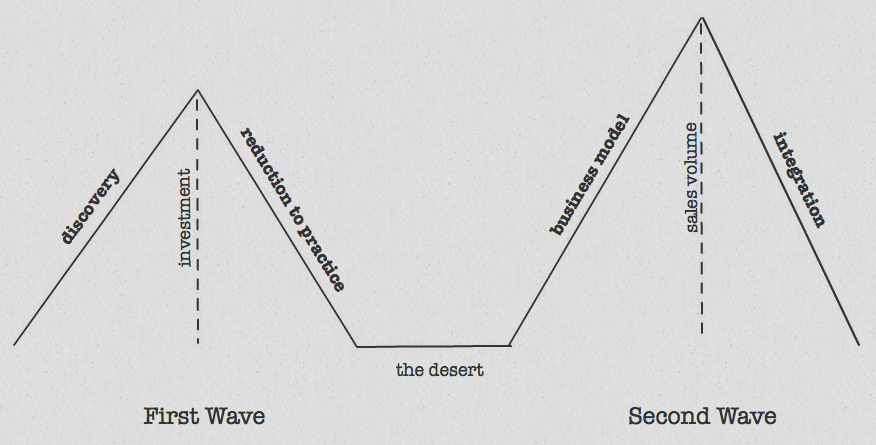Note: This is the second of a 6-part series on How to Harness the Power of Change Waves to Accelerate Growth (here’s the first). I invite you to add this series of posts to your reading list. (better yet, subscribe at right to have all future posts sent to your inbox). A note of thanks to Venkatesh Rao for his work on Hall’s Law that greatly informed my thinking for this post.
“Time is the dominant parameter. The pilot who goes through the [observe, orient, decide, and act] cycle in the shortest time prevails because his opponent is caught responding to situations that have already changed.” — Harry Hillaker, chief designer of the F-16
Developing perspective more quickly and moving to the high ground in advance of others is a key strategic skill of the modern period. In the last post, we outlined some of the tools that will allow you to get ahead in understanding technical changes more quickly than your contemporaries. In this post, we’ll go a bit deeper and look at some of the changes that recently rocked our world and those that are coming.
The Anatomy of a Change Cycle
There are two distinct waves to every large scale change, whether it’s driven by a technological breakthrough or a change in the market. Each of these waves has a front and a back: the parts of the first wave are: 1) the discovery and 2) its reduction to practice. Much later, a second wave brings: 3) the business model and 4) the integration.
Figuring out where you are on this cycle is very important because it allows you to make good choices for how to spend your personal time, distribute your business capital and choose your investments in advance of your competition.
For example, large scale financial investment in the discovery phase of a program is the classic issue that leads to massive loss of capital – think the dot com bubble in the early 2000’s. Many of those “inventions” are now coming to market with real business models doing real work – a decade later. A great example is this very cool thermostat by the designer of the iPod which had its origins in a protocol proposed in 1999.
Knowing which peak you are on takes perspective and practice, but gives you a powerful advantage.
The front side of these waves are great places to be, with much learning in the discovery phase (1) and much wealth building in the business model phase (3). The back side of the waves are often rather scary, marked by consolidation and down-selection — but can also be productive for the prepared.
Wave two forms slowly, but very powerfully. The Apple computers franchise built on superb cross platform usage of iOS happened right before our eyes for a decade before it became the most valuable company on the stock exchange. Taking an example from history, Intel peaked decades after Moore’s law became well understood.
The stark reality is that a company in the leading economic position on the last wave rarely holds onto their edge through the following set of change waves. Classic examples are Kodak and digital photography, as well as traditional encyclopedias in the wake of Wikipedia. I believe that this is because the economic benefits of the previous wave blind them to the promises of the invention phase of the next one.
Here are some of the biggest change waves we’re seeing right now:
- Mobile. Mobile is changing our lives – always available in the palm of our hand. All of our devices are “smart” – phones, cars, trash cans. You can check charge levels in your Nissan Leaf, or open your hotel room door. The key to getting in front of this trend is not to think about it as an extended desktop, but as if mobile is the only experience – something we’ll talk more about in the next post.
- Genetically-targeted medicine. In 2003, the human genome was essentially mapped, spurring the movement from mass to targeted therapies. This project has opened the door to custom medication solutions for your specific set of genes, giving it the potential to rock academics, companies and markets. Battelle documented the $3.8B in spending will drive nearly $800B in results and 310,000 jobs — exactly the geometric returns we are looking for from major change waves.
- Nanotechnology. Think about nano-robotics – nanosystems that are constructing other nano devices on a molecular scale. Applications include things as diverse as tape, packaging, sunscreens, fabrics, video game consoles, cars and smart military materials. One author, Mihail Roco, has already begun mapping nanotechnology to the industrial revolution.
- Social web. The connected generation is more comfortable socializing online than off. This means that years after the promise that distance would no longer be a limiting factor for collaboration, the tools — and people’s comfort-level in using them — have finally reached a point of integration.
A common theme of major change waves is a confluence of technology, capital and demographics. When all three peak, amazing things happen. When it is absent, however, instead of a crescendo you get more of a soft thud. Virtual presence has been one of those “thuds”, with many companies making early, deep investments ahead of the demographics – only to have much slower adoption than anticipated.
In the next post, I’ll look at another current change wave and discuss the microstructure of innovation in the context of these longer, change wave trends. In the meantime, feel free to email or tweet me with questions or observations.



